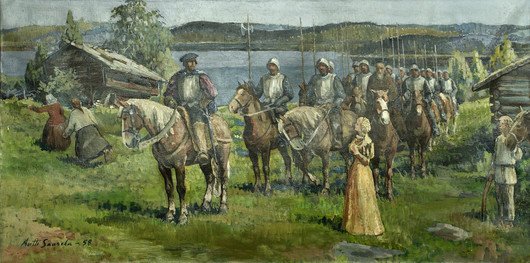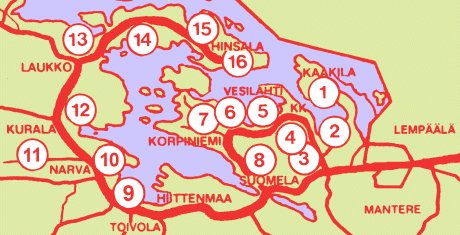THE KLAUS KURKI ROAD

Klaus Kurki was lord of the manor of Laukko and a judge in Upper Satakunta. A folk ballad tells how at the end of the 1400s he rode with a hundred horses to seek the hand in marriage of the lovely Elina of Suomela village. Kurki and his men travelled a road which had already been trodden, every channel, every rut and every hill and howl by innumerable travellers for thousands of years. Through villages, fertile fields and spruce copses this same road continues to wend its way by the hilly fringe of Alhonlahti on Lake Pyhäjärvi welcoming new visitors one after the next – and is now known as the Klaus Kurki Road.
Vesilahti is among the oldest inhabited areas of inland Finland. The first settlers arrived here just after the Ice Age, about eight thousand years ago. The rich hunting and fishing grounds have always attracted people from south-east and central Europe. A number of skilfully made artefacts in stone and ceramic have survived to commemorate the era.
Ever since the middle Iron Age, that is, since about 500 A.D. Vesilahti, like its neighbours, was involved in the trading community of Baltia, Gotland, the Rhine Valley and Rome. It was from Vesilahti that the superb furs so coveted in the south of Europe were despatched, like other products of the wilderness, and possibly also slaves. In return they received splendid weapons, precious metals, spices and beautiful jewellery. The smiths of Vesilahti were also adept at crafting weapons and plough shares. For their gorgeously attired wives they created jewellery from precious metals which came to serve as models for today’s fashion jewellery. From the hundreds of funeral mounds along the Klaus Kurki Road archaeologists have excavated only a fraction of the glories of the Iron Age. These artefacts permit the conclusion that even before the eleventh century the merchants brought with them something of a Christian world view.
Where there are riches there will soon also be a rush in pursuit of them. The rise of Novgorod and the expeditions of the Vikings all over the north of Europe constituted a threat reaching all the way to Vesilahti. This gave rise to a system of alarms which included the Onkimäki and the Kaakila hillforts. There is no documentary evidence of prehistoric life and strife extant. Even more precious and extensive reflection of these are in a body of folk poetry, whose core content was collected by Elias Lönnrot, resulting in the Kalevala, the Finnish national epic. The preface to this world-famous epic was signed in Vesilahti.
Numerous missionaries from continental Europe, among them Hunnun Herra in Vesilahti, paved the way for the new social order. Presumably Hanseatic merchants settled in Finland, their existence is reflected in tens of Vesilahti names of German origin. The power of the Church of Rome penetrated to Vesilahti not later than the 1250s, when with papal approval the Swedes ousted the Finnish Iron Age chieftains. The catholic parish of Vesilahti dedicated to St. Peter and St. Paul apparently came into being in the very early stages as a mother church of Pirkanmaa, (nowadays Tampere Region). Documentary evidence only dates from 1346. Vesilahti Church contains several mediaeval artefacts, chasubles and a stone sacristy.
Local leaders also arose to support Swedish domination, the most celebrated of these being probably Matti Kurki, who according to legend vanquished both the Novgorod chieftain Pohto and some Danish interlopers. Among the Lapps Matti was known to be an unscrupulous collector of taxes (exercising special rights). Yet Matti’s actions served to create a lasting reputation for his family in the royal house of Sweden. As a reward the Kurki family held the vast Viking age manor of Laukko for over five hundred years.
Klaus Kurki, who lived at the end of the 1400s, committed a murder as a result of invidious calumny. The events recounted by local bards has resulted in "Elinan Surma" the most famous of Finnish folk ballads. In the latter part of the nineteenth century the ballad was still habitually sung throughout the locality in the hot, dusty sauna used for flax processing. It also made its way beyond the borders of Finland.
The remarkable history of the Kurki family ended early in the nineteenth century, but the manor of Laukko continued it’s life with new owners. Finnish large-scale industry, exemplified by a company named Nokia, owes it origins to the next owner, the Törngren family of Laukko. In the early 1900s the ideals of the Labour Movement made themselves felt and achieved considerable fame through a strike by tenant farmers provoked by an eviction. To this day Laukko as a manor is very much alive; horses bred at Laukko have run very well on the tracks of continental Europe.
After the Middle Ages more extensive trading was only permitted at market fairs. Half way along the Klaus Kurki Road there is the old market settlement of Narva, which until the end of the 1700s was a trading post known throughout southern Finland. Long before that Narva had been a fur trading post. Today Narva Market has been revived as a folkloric festival held every five years (in 2005, 2010 and so on).
Vesilahti is a verdant haven among bustling growth centres. Its landscape is not marred by motorways. There are only idyllic lanes meandering through field and forest, leading the traveller into genuine rusticity. The Klaus Kurki Road wends its way through twenty kilometres of enchanting Finnish landscape with historic sites along the road. See it by bus, private car or bicycle.
For further information about tourism in Vesilahti and guided tours please contact the Municipality of Vesilahti, Lindinkuja 1, 37470 Vesilahti, tel. int. +358 (0)50 3895265, +358 (0)3 565 27500, www.vesilahti.fi

1. KAAKILA
Late Iron Age hillfort. On the lake shore by the church a bonfire site. According to tradition this was the last Lapp settlement. Scenic attraction.2. VESILAHTI PARSONAGE
The main wooden building of the parsonage dates back to 1871. The outbuildings include accommodation for a second pastor and a two-storeyed outbuilding. The Church offices are under the same roof. Close to shops K-Market Vesilahti and S-Market Vesilahti, the village information point and carpark and the Hovin Ratsutila, an ancient cavalry estate, today equestrian centre.3. TAPOLA
Residential buildings from the 1840s typifying the traditional architectural style of the province of Häme. Samotti’s pottery and gift shop and in summer the Aittakahvila café. Library.4. KIRMUKARMU
Burial site of Iron Age Chieftains, which has yielded remarkable archaeological finds, including mountings and ferrules from an Iron Age sword. In the early Middle Ages the chieftain Kirmukarmu fought against the Russians and resisted the arrival of Christianity. Youth club buildings and summer theatre.5. VESILAHTI CHURCH
The church dates from 1802, the stone sacristy from the end of the 1400s and the bell tower from 1782. Metal crosses by the smith Karl Lind can be seen in the cemetery, while the church and sacristy contain mediaeval artefacts. The municipal offices, the Kiehelä Gift Shop, Pizzeria Makasiini and Vesilahti Health Centre are situated a short walk from the church.6. SAKOINEN
Seat of Matti Kurki, local chief of the celebrated Kurki family. The manor of Laukko was given to Kurki as a reward for his merits. The place names ‘saka’ and ‘Sakoinen’ are derived from the Latin ‘sacer’, meaning sacred. Valuable Viking finds have been made in the area.7. KORPINIEMI-RAUTIALA
A beautiful, fertile peninsula extending into Lake Pyhäjärvi inhabited ever since the Iron Age. Ala-Orvola rural tourism operates in Korpiniemi, while Rautiala has a catering service and tennis court.8. SUOMELA
According to the ballad Elinan Surma this is the birth place of Elina. Scene of fighting in the Finnish Civil War of 1918 commemorated by a memorial to the White faction. Abundant bird life nearby around Lake Vähäjärvi.9. HURSKASVUORI
Formerly a place for round games and bonfires. Defence works from World War I can still be seen on the hillsides, some of them having been restored.10. NARVA
Ancient market venue. Nowadays Narva Fair is held every five years. From May to September there is a summer market on Saturdays. There is a craft centre in Vesilahti displaying and selling local handicrafts. The Harrinkulma shop, Narva Health Centre, pharmacy and library.11. VESILAHTI LOCAL HISTORY MUSEUM
Outdoor museum illustrating tenant farmer’s life in the 1800s. Many summertime events.12. KURALA
Former artisan village close to Kuralanlahti. The area has been inhabited since the Iron age. Nowadays an agricultural area.13. LAUKKO MANOR
A manor farm since the time of the Vikings. Celebrated for the Kurki family, Elias Lönnrot and strikes and evictions of tenant farmers. Mausoleum pyramid of the Standertskjöld-Nordenstamm family. Present owner is Lagerstam family. Archaeological finds have been made on the land of the manor, some of which are in the private museum of the manor. Private property.14. LAUKONHAKA
Grazing lands of the celebrated Laukko deer and the well-known Laukko trotting horses. Very old tree growth and vegetation. On the higher land unexcavated barrows.15. TUHNUNVUORI
Tuhnunvuori promontory is a sudden drop to Säijänselkä on Lake Pyhäjärvi and mentioned in numerous ancient legends. According to the ballad Elinan Surma Klaus Kurki downed himself by leaping from the Tuhnunvuori cliff. There is an enchanting path which leads through wildwood to the top of the promontory.16. HINSALA
A village which was inhabited from the Iron Age to the 1800s. Several unexcavated ancient sites. It was common in the flax-processing saunas of the houses in Hinsala to sing the ballad about Elina’s tragic death right until the end of the 1800s. Hukianhovi restaurant (advance bookings only) and Kinnair country cottages.